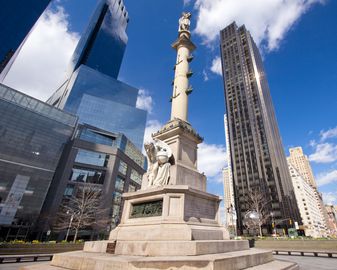

The Columbus Circle, a circular intersection where the vertical Broadway, Central Park West and Eight Avenue meet the horizontal 59th Street, is one of New York City's main orientation marks. To its south lies the Theater District, while to the north begins the Upper West Side with Lincoln Center and Central Park. It is also dedicated to a major, if not the most fundamental, figure in American history, one who, unfortunately, is rarely mentioned nowadays: the discoverer of the New World, Christopher Columbus.
Christopher Columbus was a navigator and explorer from the Republic of Genoa, who in 1492 sailed in search of a westward route to the East Indies and accidentally stumbled upon an island that he called Hispaniola, the island that today is divided by the countries Haiti and the Dominican Republic. He had been convinced that the world is round and that there was definitely a shorter way to get to Asia and India from Europe than by going through the Middle East. Unfortunately neither Genoa nor any other Italian state was interested in his proposal, and he therefore turned to the greatest European power at the time, the Kingdom of Spain, which financed his three ships and pledged to make him governor of any territories he would discover along the way.
Columbus, however, was not the first European to land in the Americas. The Scandinavian Leif Ericson had discovered Newfoundland in present-day Canada in the eleventh century. Columbus also did not think that he had discovered a new continent; he just thought he had reached the easternmost part of Asia. It was Florentine navigator Amerigo Vespucci who, after sailing down the South American coast in the beginning of the 16th century, determined that it was indeed a new continent that Columbus had discovered.
Neither did Columbus discover any part of the present-day United States of America. He never went north of the Bahamas archipelago. On his second voyage he sailed along the coasts of today's Cuba, on his third voyage, of Venezuela, and on his fourth, of Panama. It was actually another Florentine navigator, Giovanni da Verrazzano, who, in the service of France, sailed up today's New York Bay in 1524.
Yet, it was Columbus's four journeys to the New World that inspired Europe to embark upon a long and thorough colonization process of what later became known as the American continents. Columbus was proud of having spread Christianity to the New World, although he was a tough governor and was even imprisoned on one occasion after being found guilty of tyranny. King Ferdinand of Spain, his eternal patron, had him released though and for the rest of his life he lived rather comfortably, dying in Valladolid, Spain in 1506 at the age of fifty-four.
The Columbus Circle, a 148,000-square foot intersection, was finished almost four centuries after the explorer's death, in 1905. Architect William P. Eno designed the project around the monument standing in the middle, which had been constructed by Italian sculptor Gaetano Russo and inaugurated during the commemoration of the 400th anniversary of Columbus reaching the New World in 1892. The monument consists of a marble statue of the explorer looking south and standing on a seventy-foot granite column, which is decorated with bronze sculptures depicting Columbus's three ships: the Nina, the Pinta and the Santa Maria. At the bottom, on the pedestal, an angel embraces a globe. The monument was financed by the Italian language newspaper, il Progresso. In 2005 a 36,000-square foot circle with fountains, benches and plants was created around the monument.
Until the Time Warner Center was erected on the eastern part of the intersection in 2003, the most impressive building on Columbus Circle was the Trump International Hotel and Tower, and its transparent and shiny globe, standing on the northern side. It was originally built in 1969, but then remodeled in 1997 with a more sophisticated glass façade. The tower, which also offers residential condominiums, is owned by one of New York's leading real estate developers, Donald Trump.
Northeast of the Columbus Circle we see one of the main entrances to Central Park, the Merchant's Gate. In the middle, on a stone pedestal, stands the gilded bronze USS Maine National Monument, dedicated to the US Navy ship that exploded in Havana, Cuba in 1898 during the Cuban War of Independence, leading to the Spanish-American War. The statue represents the prehistoric continent of Columbia with her seashell chariot pulled by three seahorses. The Spanish-American War was a very unfortunate, but alas inevitable, geopolitical development, because America had to fight, paradoxically, against the country responsible for its discovery.